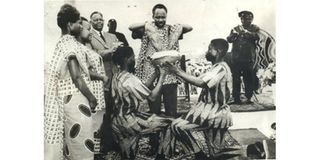Survival is the major achievement of the union of Tanganyika, Zanzibar

lic of Tanzania, Mwalimu Julius Nyerere, mixes the soils of Tanganyika and Zanzibar on Union Day in 1964 as Sheikh Abeid Amani Karume witnesses. PHOTO | FILE
What you need to know:
- For example the fact that the Union agreement was signed between Mwalimu Julius Nyerere and Sheikh Abeid Amani Karume some four days earlier, on April 22, 1964 in Zanzibar, was news to me.
The other day I was requested to give a presentation on the history and philosophy behind the union between Tanganyika and Zanzibar which this week clocked 58 years.
The presentation was to be made before over 1,000 students and teachers in Njombe town. And the moderator and guest of honour was none other than the newly appointed dynamic and exciting Njombe governor or rather regional commisioner Waziri Kindamba.
When I asked ‘why pick on me’ I was casually informed that I was one of the now rare species who lived before and after the Union.
Indeed when the Union was formed I was nine and a half years old and in Class IV. And I vividly remember that date because it was a holiday, and pupils tend to love and worship holidays.
For the simple above reasons I easily accepted the invite. But first, not to look stupid, I had to do some brief research on the subject. It was only then that I realised that apart from knowing that April 26, 1964 was the day when the Union was consumated, I knew little about the circumstances behind this unique Union.
For example the fact that the Union agreement was signed between Mwalimu Julius Nyerere and Sheikh Abeid Amani Karume some four days earlier, on April 22, 1964 in Zanzibar, was news to me.
This was officially endorsed by Parliament of the Republic of Tanganyika and the Revolutionary Council of Zanzibar on April 26, 1964. And the Articles of the Union were exchanged between the two leaders a day later, on April 27, 1964 at the Karimjee Hall in Dar es Salaam.
It would take six months, on 28 October 1964, before the name of the the Union, the United Republic of Tanganyika and Zanzibar, to change to the current United Republic of Tanzania.
The reasons behind this epochal event were the facts that there were strong historical, commercial and familial relationship between the two sides.
The common language and strong cultural ties were other factors as well as the close partnership between the mainland Tanganyika African National Union (Tanu) and the Isles’ Afro Shirazi Party (ASP) ruling political parties. Naturally, security concern was also a major factor following the revolution in Zanzibar.
Actually this would also fit well in Nyerere’s philosophy of forming a United Africa through regional blocks. It should be recalled that Mwalimu Nyerere was prepared to delay Tanganyika’s independence, in 1961, if that would allow the yet to be independent Uganda and Kenya get theirs and then form an East African State.
Now what can we say about the Union? Nyerere was once asked about the achievements made by Tanzania, I believe when the country marked its 20th anniversary. “The fact that we have survived,” responded Nyerere.
Indeed this unique Union is a success. Look at what happened to the once powerful Union of the Soviet Socialist Republics (USSR) which had more than 15 republics. Come Goberchev’s Perestroika, it came crumbling down like a pack of cards. The current tragic Russian war in Ukraine is testimony to this development.
Then there was the much heralded Senegal and Gambia union, Senegambia, in 1981. It lasted for eight years only before collapsing. The Arab Maghred Union, of Libya, Algeria, Mauritania, Morroco and Tunisia lasted only nine years before it also died in 2008.
The United Arab Republic composed of Egypt and Syria died in 1961 after only three years. Even the mighty United States of America became fully united after a major civil war to bring back the 13 states which had receded in the 1860s. More than 650,000 soldiers and 30,000 civilians were killed.
Suffice it to say the Union is a vital cog in the wheels of development in the country and the promotion of peace and security in Bongoland. That it is still alive is cause for celebration.
If I were to be asked about the achievements of the Union in its 58 years of survival, I would, as Nyerere would have said, say “It has Survived.” The challenges notwithstanding!





